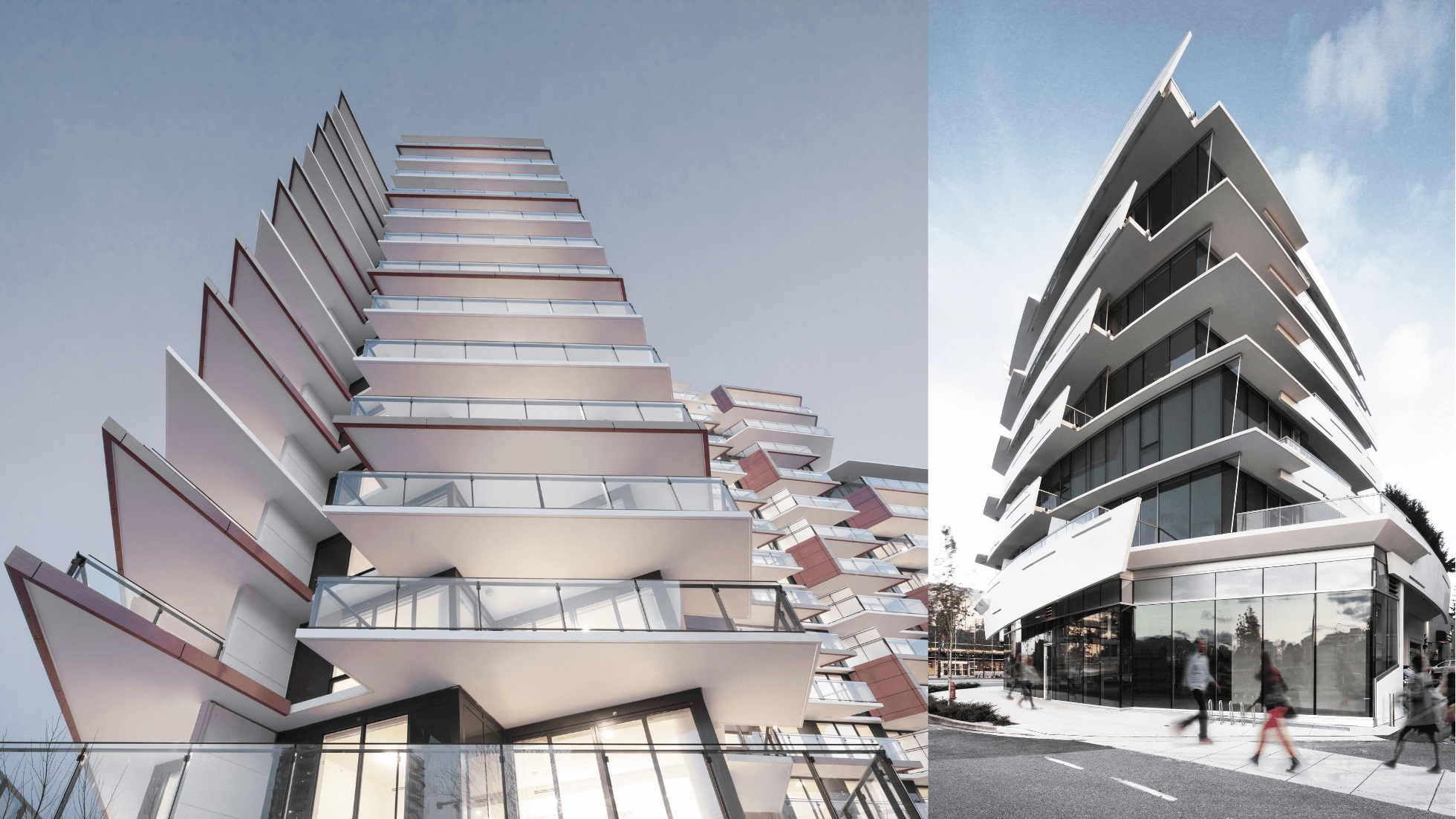- Arno Matis Architecture + Urbanism is leading innovation in AI building permit automation through the Multi-AR system, which accelerates multi-residential project approvals.
- Based on BIM data and AI-powered analysis, Multi-AR transforms slow, PDF-based permit reviews into real-time compliance checks—potentially reducing timelines dramatically.
- Faster approvals could also lower development costs and improve housing affordability, supporting Canada’s urgent need for new homes.
Visitors and residents of Vancouver, Canada, and the Metro Vancouver Regional District have likely admired some of the distinctive shapes of Arno Matis Architecture + Urbanism (AMA+U) projects. For nearly 30 years, AMA+U’s mid-to-large-scale buildings have caught the eyes of passersby with their elegant, modern forms inspired by the surrounding environment. Notable AMA+U works represent the shape of wind, the flow of water, or the patterns of the Pacific Northwest forests.
The mid-scale firm’s Principal, Arno Matis himself, has been personally involved in the design of every completed AMA+U project or project in development, of which there are many—perhaps too many. The firm has many projects still in development because the municipal review process is making it difficult to keep pace with Canada’s growing housing needs.
In mid-2025, the Canada Mortgage Housing Corporation (CMHC) reported that the country will need 430,000 to 480,000 new housing units (ownership and rental) per year through 2035 to fill its housing supply gaps. That’s double the country’s current pace of development. That kind of step up in production will need accompanying improvements to the current building permit approval process, which Matis says can often take multiple years, leading to exorbitant holding costs.
“The municipalities just haven’t kept up with the kind of demand for accommodating growth,” Matis says.
That’s why AMA+U has led a collaborative project to proliferate AI building permit automation with the new Multi-Automated Review (Multi-AR) software for automating regulatory and bylaw compliance reviews for multi-residential projects.

Arno Matis, Principal and Founder of Arno Matis Architecture + Urbanism. Courtesy of AMA+U.
A Crisis of Time and Cost
A confluence of factors has Canadian provinces and municipalities playing catch-up on development and has caused a crisis for affordable housing. For one thing, a large influx of foreign real estate investment beginning in the 1990s caused prices to skyrocket.
Then Matis describes how a series of transit infrastructure projects, including the Canada Line around the 2010 Winter Olympics in Vancouver and the Broadway Subway Project (opening in 2027) set municipalities scrambling to deal with the subsequent planning.
“The zoning bylaws couldn’t keep up and became obsolete,” he says. This led to negotiating planning minutiae with officials, longer timelines, and permit approvals grinding to a halt.
In addition, peaking interest rates during the COVID-19 pandemic further exacerbated unaffordable housing, hitting cities like Toronto and Vancouver particularly hard. On top of that, a significant increase in immigration occurred post-covid without planning for additional housing and associated services.
The present situation sees already unaffordable housing compounded with a lengthy permit approval process that forces high carrying costs onto developers. Matis says that in the three-stage permit approval process for many projects, it can take a year or two for rezoning, another year for development permits, and around six months for building permits.
In a worst-case scenario, “it’s not uncommon to see projects sitting in the approvals stage for five years,” he says. “We’re now seeing the bizarre situation where it sometimes takes longer to move a project through the approval stages than it does to actually build it.”

Aperture, located in Vancouver, BC, is a multi-residential project with facade openings that are programmed to open and close in response to the solar exposure of each facade. Courtesy of AMA+U.
The Development Killer: Carrying Costs
Canada’s extended development delays result in exorbitant carrying costs that can run into the millions for certain projects. Matis says these backbreaking costs are killing the development industry because they can’t just pass those costs along in the current economic climate.
“Those numbers add up to eye-watering levels,” he says. “It’s not a productive use of capital. We’re tying up capital just because of the way bottlenecks have evolved in the system, not because the system has to be like this.”
Fortunately for everyone involved, Matis says that politicians and policymakers, along with the media, understand that these time delays dramatically add to development costs.
Meanwhile, most big architecture, engineering, construction, and operations (AECO) firms have transitioned away from analog drawings and static PDFs to dynamic 3D BIM files embedded with rich metadata. And AI and cloud processing make automating BIM data analysis fast and affordable.
That adds up to a tremendous opportunity to streamline the permit-approval process using technological innovation.
Multi-AR Leans on BIM Data to Evolve Permitting
Arno Matis Architecture + Urbanism (AMA+U) has led the initiative that has borne fruit in the Multi-AR technology. This tool accelerates the approvals of multifamily housing projects by automating BIM data analysis for zoning and code compliance.
AMA+U spearheaded Multi-AR first through discussions with DIGITAL, Canada’s Global Innovation Cluster for digital technologies, and then by partnering with Archistar to leverage its AI-powered eCheck automated permit review technology. Rounding out the collaboration, SolidCAD ensures Multi-AR’s data interoperability with different industry-standard formats and tools, such as Autodesk Revit and Autodesk Construction Cloud platforms.
By upgrading regulatory compliance automation from static PDF files to BIM, architects and planners alike enjoy real-time compliance visibility from dynamically updating information. If a designer updates the measurements of a wall module, for example, the Multi-AR system automatically updates compliance results for zoning, energy, and code requirements.
Matis likens this move from static PDF drawings to BIM data for permit reviews to the move from hand drawing to AI-led design. With the right alignment of key industry players, Multi-AR could compress months or even years of approval time into minutes.
For one thing, Matis says municipalities can align their bylaws and building codes to be more easily readable by automated software. They could do this by increasing the number of quantitative measurements in their permit policy rules, as opposed to qualitative regulations, which require a person to make a decision. “You could easily cut 60% out of that review process by focusing on qualitative regulations,” he says.
Aligning regulatory compliance with automated BIM-data checking would also bring the permitting process in line with the rest of the AECO sector, Matis says, which already uses BIM digital twin technology to streamline the design, fabrication, and post-occupancy management of buildings and building components.
“With BIM data, we really have the promise of finally bringing our whole industry into the 21st century,” he says.

Wind-Shaped Tower residential building in White Rock, BC (left) and 2211 Cambie mixed-use commercial/residential building in Vancouver, BC (right). Courtesy of AMA+U.
Is Affordability Too Much to Ask?
Matis says that a fully digitalized AECO industry with BIM data as the centralized hub for design, fabrication, regulatory-approval, and lifecycle-management information would bring “massive” gains in productivity and efficiency.
That’s great news for the prospect of sustainable growth and an expedient housing supply. He can only speculate as to whether dramatic reductions in holding costs due to faster approvals would be passed on to make housing more affordable for home buyers, but the potential for such affordability is there.
“If we cut approval timelines by half and lower taxes and fees, we could reduce housing costs by 20 to 30 percent,” Matis says. “This is money that should be passed on to buyers. It’s money that doesn’t show up anywhere in their unit—not in a bathroom or a kitchen. It’s just money for bureaucratic purposes, and it doesn’t have to be this way.”
Matis adds that with the economy at an inflection point and the maturity of BIM and data analysis technology baked into Multi-AR, the time is right to rethink the way approvals are handled, and he’s excited about the future of AI building permit automation.

Oak & 67th is a commercial and market residential development in Vancouver, with four buildings that were inspired by teahouses, each featuring "Shoji-like" screens. Courtesy of AMA+U.
The Future of Building Permitting
For Canada, as well as countries and municipalities around the world, the bright future they hope to see will have to come sooner rather than later. CMHC’s estimates call for Canada to build 4.8M new homes by 2035 to restore affordability.
With such a tight deadline looming, the days of multiyear permit reviews have to be numbered. If things develop the way Matis says will benefit everyone, they will be.
“Nobody says it should take three years to get a permit,” he says. “Sometimes we just scratch our heads and wonder, ‘How did we get here?’ Now’s the time to introduce a new way of working and make a dramatic difference.”
The potential for a BIM-based automated approval system like Multi-AR to accelerate compliant construction at scale could lead to both economic relief and systemic reform. At its best, AI building permit automation could help the worldwide housing supply chain to flourish—affordably, productively, and sustainably.

